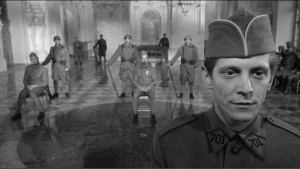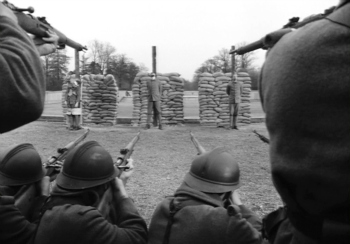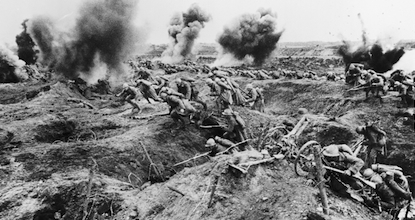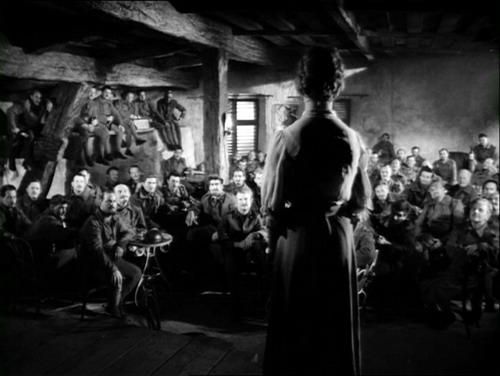How did Stanley Kubrick’s work as a photojournalist inform and conflict with his directorial approach in creating his feature film Paths of Glory?
“What is an image without imagination?” Jean-Paul Satre.
Aged 16, Stanley Kubrick, now considered one of the greatest film makers of all time, was struggling to get the grades he needed to secure a place at college. He had sold some of his photographs to Look Magazine in New York and they took him on as a staff photographer ‘out of pity,’ he comments.
Three years later, he expanded a picture story he had done for Look about a boxer, into a short documentary entitled Day of the Fight and sold it to RKO. Another short followed, along with two feature films co-funded by family and friends. Just seven years after Day of the Fight, Kubrick directed Paths of Glory starring world renown actor, Kirk Douglas. The film is now considered one of the greatest war (or more precisely anti-war) films ever made. Simon Bourgin Newsweek magazine Bureau Chief in Los Angeles stated it’s “almost a perfect motion picture, if you had to edit the goddam picture you couldn’t take anything out of it.” [1]
Kubrick did not study film. He never went to University. Instead he spent those years honing his skills for telling stories through images, working as a photojournalist. In fact he never put down the camera, operating handheld shots on all his feature films. Kubrick is often celebrated as bringing documentary realism into his fiction film projects, as James Monaco observes, “Kubrick’s cinema is a laboratory in which the various contrasting elements of still and movie aesthetics are rigorously tested…for many years Kubrick stood alone as the only director to have successfully bridged the gap between stills and movies.” [2]
Kubrick said of ‘Paths of Glory’ by Humphrey Cobb, “it was one of the few books I’d read for pleasure at high school.” [3] Cobb’s story unfolds around three World War I soldiers who are tried and executed for cowardice in France to cover up the maddening actions of a General. The title comes from Thomas Gray’s ‘Elergy written in a country churchyard’ in which the poet cautions ‘the paths of glory lead but to the grave.’
General Mireau (George Macready) hopes to gain promotion by ordering his men to carry out a suicidal charge. Afterwards Colonel Dax (Kirk Douglas) bears witness as three men are picked to be executed for desertion to set an ‘example’ to rest of the troops for failing to attack the enemy stronghold. The General sacrifices his men in battles fought, based on his own desire for self advancement. He even fires on his own men when they pull back after realising it is a suicide mission.
Kubrick had never been in the military and considered himself fortunate to not have to have fought in any war “I never would have volunteered.” But war was a subject he would return to for three of his feature films and he was fascinated by the strategy of generals; “for all its horror, war is pure drama, probably because is it one of the few remaining situations where men stand up for and speak for what they believe to be their principles.” [4]
Kubrick wasn’t a soldier but he was a photojournalist and the questions of truth, objective and subjective, along with issues of ethics and representation that photojournalists grapple with on each and every assignment, informed his work as a film director. It is indeed what set him apart in that arena.
“Photojournalism might be the perfect ideological practise: while it seems to presents objects as they are in the world, it places those objects within a system of social relationships and constitutes the viewer as a subject within that system. ” [5] Kubrick was acutely aware of his audience’s experience when creating his films. It was of the upmost important to him that they would believe the truth in what they were seeing, despite the film’s fictional framework. Kubrick totally immersed himself in the world of Paths of Glory. He researched fastidiously; what brand of cigarettes did the French soldiers smoke? What newspapers did they read? What songs were sung? How did they trim their beards? What pinups were tacked to trench walls? What did they talk about? He combed through the photo archives of the Los Angeles library for hours, studying details of trench warfare, to ensure he could replicate visually an authentic battle scene.
The Battle scene
“Every image of the past that is not recognized by the present as one of its own concern, threatens to disappear irretrievably.” [6]
Kubrick insisted he did not want conventional war explosions that produced clouds of dust and sand. He wanted verisimilitude. A shell explosion threw mud, stones and shrapnel into the air that tore into the ground. SFX supervisor Erwin Lange even had to request special permissions from the German government to access the vast amounts of explosives Kubrick was demanding for his film. Lange experimented with new techniques to simulate shell explosions and miles of electrical cable lined the field to detonate the charges.
In the first week of principle photography, almost a ton of explosive material was detonated. Kubrick explains in Newsweek in 1957 “We prepped the battlefield 500yds wide, 300 feet long. After we’d dug and blasted up the field, we put a great many little props around; ruined guns scattered in different holes, and bits of soldier’s tunics, you couldn’t see them but you could feel them…. Most of the time was spent in planting explosive charges, it took half a day to set up and 30 seconds to shoot.” [7]
Authentic WW1 shells, abandoned equipment and weapons were dressed over the expanse. Barbed wire was strewn across to form line patterns. Kubrick wanted a crashed WW1 airplane in front of the hill as a grim reminder of the futility of the situation.
All this on an independent budget of just over $600 000, below the line. He didn’t have a lot of money to spend, but was adamant on creating an immersive, real experience for his audience. “I cannot give a precise philosophical meaning of Paths of Glory. It is intended to involve the audience in an experience. It is thus misleading to try to sum up the meaning of a film verbally.” [8]
He used German police for the eight hundred soldiers featured in the film because they all had three years of military training so knew how to move under fire, how to handle a weapon. He did have problems though with performance. The Germans fought bravely on camera, at which point Kubrick had to step in and explain that these soldiers were beaten and exhausted. Paths of Glory is not about the bravado of war but about its senselessness.
One of the actors, Anderson, comments, “the trench was gruesome, it just reeked and the weather was so lousy. We all had colds and were sick from the first week. We looked awful and it certainly added to the movie.”
Relentless tracking shots in the French trenches are often cited as some of the most memorable shots of the film. Also Kubrick’s use of his handheld camera during the battle scene made film critic Peter Cowie comment “Kubrick handled the camera unflinchingly like a weapon.” [9] Whilst not many film directors operate their own cameras, this is of course, second nature for a photojournalist.
Kubrick wanted his camera to dolly through the trenches to reveal the miles of endless misery on master shots but tracks could not be laid because he also wanted to see dirt under the men’s boots. He ordered the trench be dug six feet wide to accommodate the dolly, much to technical advisor Otto Von Waldenfel’s protests that the original French trenches would have been narrow. Here Kubrick breaks with his conventions of verisimilitude of the photojournalist. This is where Kubrick the artistic Director steps in. “We must frame the production and use of reality images as ‘mediated communication’ rather than as ‘objective truth’. The Future of visual truth depends on the integrity of the photojournalist and everyone else- subjects, editors, viewers – involved in the process” [10] states Newton. Kubrick certainly would have agreed.
The Court Martial scene
“The first casualty when War comes, is truth.” Senator Hiram Johnson, 1917 [11]
 Paths of Glory starkly contrasts the splendour of the General’s châteaux with the awful lives of the men obeying his orders in the trenches. High wide-angle shots of the châteaux interior are contrasted against the bleak, gray, constantly tracking shots of the men in the trenches and battle. Kubrick cites two master film makers as his teachers; Max Ophul’s fluid tracking shots and Orson Welles’ signature of deep focus low wide-angle shots are evident throughout his films.
Paths of Glory starkly contrasts the splendour of the General’s châteaux with the awful lives of the men obeying his orders in the trenches. High wide-angle shots of the châteaux interior are contrasted against the bleak, gray, constantly tracking shots of the men in the trenches and battle. Kubrick cites two master film makers as his teachers; Max Ophul’s fluid tracking shots and Orson Welles’ signature of deep focus low wide-angle shots are evident throughout his films.
Kubrick was an avid chess player. This visual metaphor he exploits to the fullest during the Court Martial scene. The marble floor is a chessboard. With repeated use of high angled shots, the audience understands the three men on trial are pawns in a human game of strategy. The truth of the scene is that the truth is in fact irrelevant. These men are not guilty of desertion and do not deserve to be executed. Their lives hang in the balance due to the General’s own quest for power and self advancement.
This is an iconic scene in cinematic history. But what makes an Icon? “An iconic image does more that reproduce a structure of power… It provides a reflexive awareness of social forms and state actions that can lead to individual decisions and a collective movement on behalf of democratic ideals.” [12]
Kubrick’s directorial handling of this scene, his visual chess game metaphor, leaves the audience under no illusion of the injustice and so they are enraged by it. It is this emotional response that ensures the images remain in our consciousness long after the final credits have rolled. Didi-Huberman expands on an image’s ability to do this; “The philosophical debate on the powers of the image: veil or tear? The dual system of the image. That the imaginary cannot be reduced to the specular. Susan Sontag and the “negative epiphany” Ka –Tzetnik and the photographic “rapture” , Jorge Semprun and the ethical moment of the gaze. “To abruptly attend our own absence.” [13]
The Execution scene
“Every photographer dreams of capturing that one great shot, that magical moment of passage from life to death.” David Hume Kennerly, Pulitzer Prize winning Combat Photographer. [14]
 Baer argues in The Photography of Trauma, that photographs are not merely snapshots in an ever flowing, unstoppable history of time. Rather that some photographs have the power to “arrest the gaze and captivate the imagination because they guarantee no way out of the photographed instant. “
Baer argues in The Photography of Trauma, that photographs are not merely snapshots in an ever flowing, unstoppable history of time. Rather that some photographs have the power to “arrest the gaze and captivate the imagination because they guarantee no way out of the photographed instant. “
Baer examined photographs that highlighted the gap between “what we see and what we know”. In this way Baer underlines that our knowledge of history and historical events is a construction; a story narrative. He also argued against critical theory stating that a photograph is window into a past moment, a ‘frozen moment’ [15] something distant and over; “we need to grasp theoretically how it is that photographs can seem more real that reality itself.” [16]
This is because rather than a mere copy of the moment, in which the photograph literally records what it sees when the shot is taken, a photograph is actually a “standpoint, for a world view: it is a ideological gesture.” [17]
Kubrick’s Execution scene in Paths of Glory is absolutely a world view. His. He takes time in the build up to the final moment, a singular drum beat on the sound track signals the inescapable fate of these three men. It is unrelenting, until the very last. Salvation does not come. In contrast to the emotional build up of the men being marched to their death by firing squad, the moment the triggers are pulled and the bodies go limp, Kubrick cuts the scene. There are no lingering close ups on faces. No lights going out of the men’s eyes. They are simply put to death in an instant. The scene is over.
But why photograph trauma? Why re-serve up to the eye the visuals of an act of violence? Photographer Bataille published his Chinese torture photographs in The Tears of Eros 1961, arguing that placing violence in a historical context shields us from “the representation of what man really is.” [18] If we confront the ‘zenith of horror’ in these photographs, then evil cannot spread, whilst we busy ourselves looking the other way, convinced of its non existence.
I believe Kubrick has the same intention. “It’s like when young boys were fed nonsense about the glory of war. They might go off to war with expectations that didn’t turn out to be true, whereas if they had been exposed to brutal, violence war films, they might have realized what was in store for them.” [19]
Kubrick saw it as his duty to put the record straight. The film may be set in World War I, but its truth on the absurdity and atrocity of war is a universal truth, echoing throughout time and space.
“We are hard wired to understand ethics. Every competent rational adult human being wants to avoid being killed, caused pain, disabled or denied freedom or pleasure unless there is some good reason for it… these are direct harms. Indirect harms are also those that cause injury of some sort to the community or to a group larger than a single individual. These include promise breaking, cheating, deceptions, disobeying laws and neglecting one’s duty.” [20]
Glorification of war tells us to suspend our code of ethics. In Paths of Glory, Kubrick tells us not to. If we do, then anyone, even the innocent, can be put to death.
The Final scene
“Humankind lingers unregenerately in Plato’s cave, still reveling, its age-old habit, in mere images of the truth.” [21]
The epilogue for the film ends on a note of hope for humanity. The captured German girl is forced to sing for the troops whose jeering is silenced by her good nature. This reveals these men have not lost their basic humanity, despite the inhumane conditions they have been made to endure. The montage of images of the haunted faces serve as Kubrick’s final reminder to his audience of the futility of war games.
“Feelings are more important than intellect. The audience responds to a film by its feeling not through any conscious analysis of what it has seen… People go to movies to have some kind of intensive experience whether it’s comic, tragic, or horror and the biggest sin is to deprive them of it.” [22]
For all his insistence on verisimilitude, Kubrick manipulated his frames to ensure that above all, the audience feels something when they see his images. His truth, is a subjective form. That is why his images are iconic, why they stand above most others, why he transformed from a promising young photojournalist into one of the world’s greatest film directors.
The European reaction to Paths of Glory was swift and outraged. The French military tried to have it banned. Protests in Brussels caused the film to be pulled after its first run at theatres and only later returned with a caveat at the start “this episode of 1914-1918 war tells of the madness of certain men caught in it’s whirlwind.” Under pressure, the film was withdrawn from the Berlin Film Festival. Paths of Glory was only allowed to be show in US and British sectors of Berlin and in West Germany. Switzerland banned it as ‘subversive propaganda directed at the French.’ The Italians voted it best foreign film of 1958 and awarded it the Silver Ribbon. [23]
Kubrick died before I entered the film industry but I am fortunate to work with colleagues who worked directly with him. They recount tales of playing tricks on his OCD nature; giving him redundant faders to play with in the sound mix for example and reveal moments of seeming haphazardness, like when he instructed the technician to ‘use that piano piece again’ when they had run out of music during the final scoring of what was to be his last ever film, Eyes Wide Shut.
Critics often remark that Kubrick’s repeated use of ‘that piano piece’ is a masterful stroke of repetition, effectively conjuring up an inescapable sense of dread. Rather than master craftsmanship, the story I’ve shared with you might make it seem like an accident. In truth, a film is a construction of so many moving parts there are a multitude of mistakes and fortunate accidentals along the journey of its construction. The genius of Kubrick, was to know the difference.
By Susan Luciani
MA GRADE : DISTINCTION
[1]Lobrutto , V – 1999 – Stanley Kubrick A Biography – Da Capo Press – New York [2]Lobrutto , V – 1999 – Stanley Kubrick A Biography – Da Capo Press – New York [3] Phillips, G ed – 2001 –Stanley Kubrick, Interviews – University Press of Mississippi [4]Lobrutto , V – 1999 – Stanley Kubrick A Biography – Da Capo Press – New York [5]Tagg, J – 1988 – The Burden of Representation: Essays on Photographies and Histories – Amherst: University of Massachusetts Press [6]Benjamin, W – 1969 – Illuminations, ed. Hannah Arendt, trans. Harry Zohn – New York: Schocken [7]Lobrutto , V – 1999 – Stanley Kubrick A Biography – Da Capo Press – New York [8] Phillips, G ed – 2001 –Stanley Kubrick, Interviews – University Press of Mississippi [9]Lobrutto , V – 1999 – Stanley Kubrick A Biography – Da Capo Press – New York [10] Newton, J. – 2001- The Burden of Visual Truth; The role of Photojournalism in Mediating Reality – Mahwah, NJ: Lawrence Erlbaum Associates [11] Knightley, P. – 2004 – The First Casualty: The War Correspondent As Hero and Myth- Maker from the Crimea to Kosovo – The Johns Hopkins University Press [12]Harriman, R., Lucaites, J. L. – 2007- No Caption Needed: Iconic Photographs, Public Culture and Liberal Democracy – Chicago: University of Chicago Press [13] Didi-Huberman, G. – 2008 – Images in Spite of All – The University of Chicago Press [14]Perlmutter, D. D. – 1998 – Photojournalism and Foreign Policy: Icons of Outrage in International Crises – Westport CT: Praeger. [15]Crary, J – 1990 – Techniques of the Observer: On Vision and Modernity in the Nineteenth Century – Cambridge, Mass MIT PRESS [16] Baer,U. – 2002 – Spectral Evidence: The Photography of Trauma – MIT, USA [17]Flusser, V – 1998 – Standpunkte Texte zur fotografie, ed Andreas Muller_Pohle – Gottingen: European Photography [18] Baer,U. – 2002 – Spectral Evidence: The Photography of Trauma – MIT, USA [19] Phillips, G ed – 2001 –Stanley Kubrick, Interviews – University Press of Mississippi [20] Lester, P. ed. – 1996 – Images That Injure: Pictorial Stereotypes in the Media – Praeger: Greenwood Publishing Group, Inc [21] Sontag, S. – 1979 – On Photography – Harmondsworth: Penguin [22]Lobrutto , V – 1999 – Stanley Kubrick A Biography – Da Capo Press – New York [23]Lobrutto , V – 1999 – Stanley Kubrick A Biography – Da Capo Press – New York
